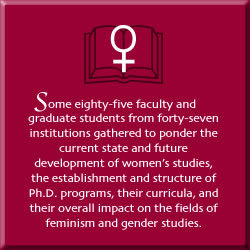|
Volume
78
Number
1

Playing
by the Book
The
Magic of Science
Vaccine
Research Center
A
Gringa Goes to São Paulo


Emory
University
Association
of Emory Alumni
Current
News and Events
Emory
Report
EmoryWire
Knowledge@Emory
Sports
Updates

|
|
|
|
Women’s
studies Ph.D.:
We
have arrived
One
of the first institutions in North America to offer a graduate
degree in women’s studies nearly a decade ago, Emory remains
at the forefront of the ever-expanding academic arena devoted
to women and minority groups. The University took a leading
role in hosting the first-ever national Working Conference on
the Ph.D. in Women’s Studies: Implications and Articulations,
held last fall at the Emory Conference Center.
Some
eighty-five faculty and graduate students from forty-seven institutions
gathered to ponder the current state and future development
of women’s studies, the establishment and structure of
Ph.D. programs, their curricula, and their overall impact on
the fields of feminism and gender studies. Participants came
from the dozen institutions that now offer Ph.D. programs in
women’s studies as well as many others whose programs are
in the planning stages. Future collaboration among these colleges
and universities was one of the primary goals of the conference.
 For
pioneers who fought for the scholarly legitimacy, acceptance,
and growth of women’s studies programs, the national conference
was a welcome landmark. In an follow-up essay about the conference
experience, Associate Professor of Political Science Beth Reingold
wrote, “…more and more colleges and universities are
advertising for faculty positions in women’s studies, and
requesting these applicants have a Ph.D. in women’s studies.
There is now a ‘market’ for women’s studies Ph.D.s.
For those of us who helped build the women’s studies Ph.D.
program here at Emory, these recent developments are exciting
and gratifying.” For
pioneers who fought for the scholarly legitimacy, acceptance,
and growth of women’s studies programs, the national conference
was a welcome landmark. In an follow-up essay about the conference
experience, Associate Professor of Political Science Beth Reingold
wrote, “…more and more colleges and universities are
advertising for faculty positions in women’s studies, and
requesting these applicants have a Ph.D. in women’s studies.
There is now a ‘market’ for women’s studies Ph.D.s.
For those of us who helped build the women’s studies Ph.D.
program here at Emory, these recent developments are exciting
and gratifying.”
Conference
organizers, including Frances S. Foster, director of Emory’s
Institute for Women’s Studies, encouraged lively participation.
“There was no show and tell,” Foster says. “Everybody
who came had a role to play and came ready to talk about what
we do, how we do it, why we do it, what’s really working,
and where we go from here.”
The
compelling conversations that ensued are continuing through
e-mail conversations among the participants around the country
and beyond. “The conference on the women’s studies
Ph.D. may have ended on October 14, but the discussions it fostered
are far from complete,” Reingold wrote. “The conference
was intended to begin an ongoing process of collaboration; the
impact of the conference was meant to be long lasting.”–P.P.P.
|
Debating
race
A
respected civil rights leader who earned his stripes in the
1960s and a two-time African-American Republican presidential
candidate shared the Glenn Auditorium stage and exchanged admiration
for one another during “The State of Race,” a debate
planned in recognition of Black History Month in February.
Alan
Keyes, former ambassador to the United Nations Economic and
Social Council during the Reagan administration, dismissed the
very idea of race as a lie perpetuated by American power structures
to divide and demoralize minorities. He called race “a
tool to shackle the minds of people in America.”
But
Julian Bond, now chairman of the National Association for the
Advancement of Colored People, warned that race, while a socio-political
construct, is “not just a pigment of our imagination.”
Although hard-won gains have been made toward racial equality,
Bond reminded listeners that there is but one generation “between
Julian Bond and human bondage.”
Toward
the end of the evening, an Emory student asked the two prominent
African-American leaders how race relations might be improved
on college campuses. Both responded that students must step
up their efforts to become fully integrated on campus, rather
than having a diverse student body that simply re-segregates
into comfortable, seperate minority groups.
“Students
should be required to fully participate in the university community,”
Keyes insisted. “I don’t think that’s a challenge
they ought to be able to walk away from.”
|
New
fellowships strengthen old ties
When
Emory professors retire–often after many years devoted
to teaching and scholarship–they may be gone from the classroom,
but a new fellowship program lets them know their work is not
forgotten.
For
the first time, emeritus professors who continue to actively
conduct research and publish can receive support through the
Heilbrun Fellowships, newly established to foster these scholars’
lasting ties to the University. Named for Distinguished Research
Professor of Psychology Emeritus Alfred Heilbrun, who received
one of the first awards, the $10,000 year-long fellowships are
funded through a grant to Emory College from Heilbrun’s
daughter, Lynn Stahl, and her husband, Jack. Fellows are given
work space in Woodruff Library.
Heilbrun
and Herbert Benario, professor of classics emeritus, who also
received one of the initial fellowships, were honored at a November
reception hosted by the Emeritus College.
“Too
often when professors retire, they wake up and find they have
no connection whatsoever to the University,” says John
Bugge, an English professor who chaired the committee that selected
the fellows. “So we’re trying to reestablish that
connection on several fronts.”
Heilbrun
plans to use the funds to complete a book on behavior disorders,
his third book since his retirement in 1991. Benario will continue
a survey of scholarly work written on the Roman historian Tacitus.
The Heilbrun fellowship will help him make his annual sojourn
to Europe, where he will mine the wealth of material on Tacitus
housed in Munich.
“This
is a program that can be increased, insofar as it provides a
bridge between working as an active faculty member and retaining
a commitment to research and scholarship as a retired person,”
Heilbrun says. “Those are often separate stages.”
Benario
agrees: “Not all emeritis disappear.”
|
|